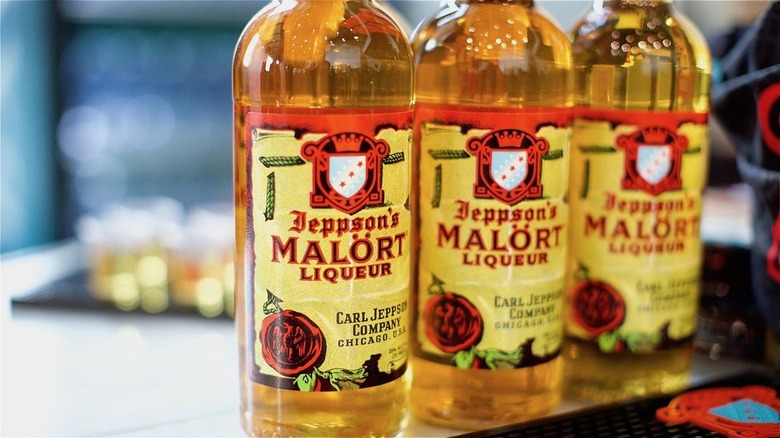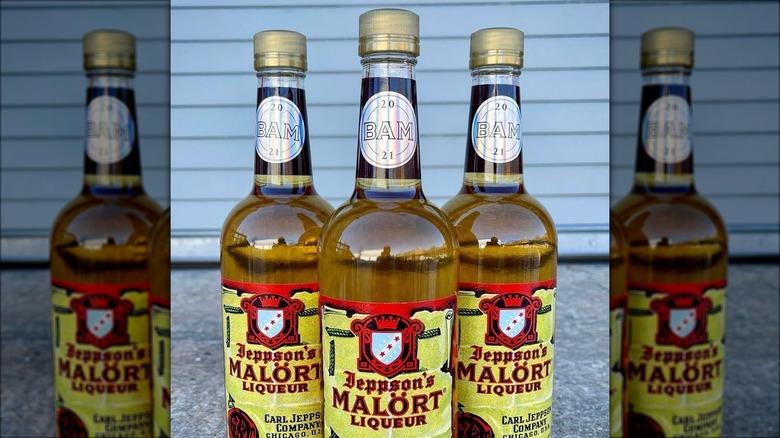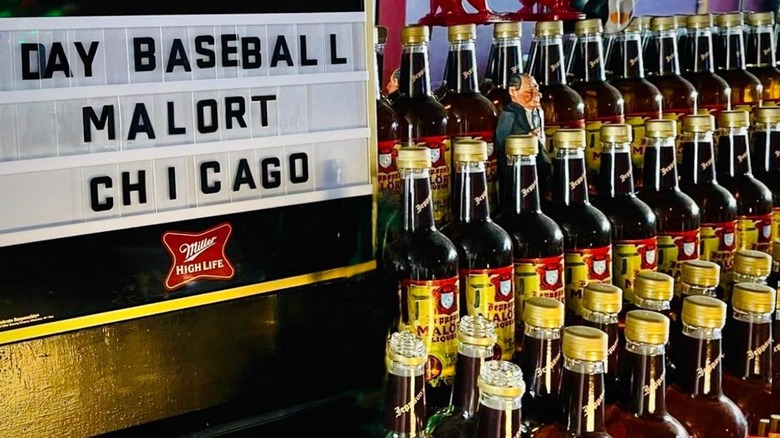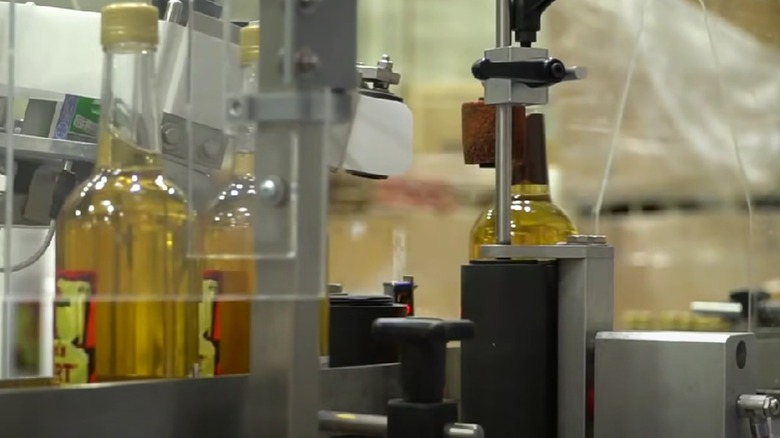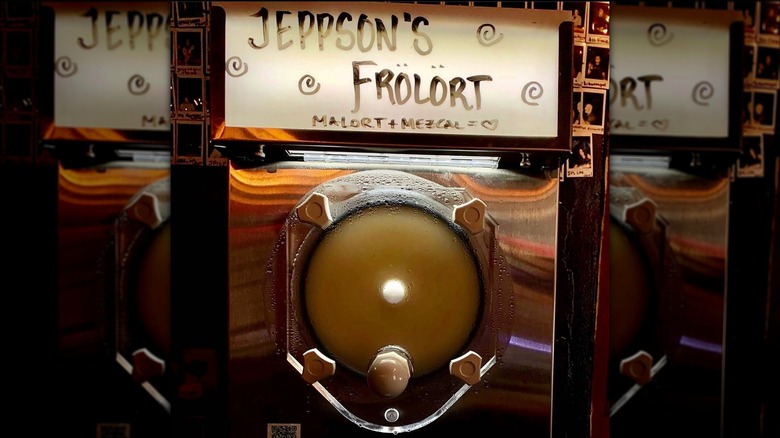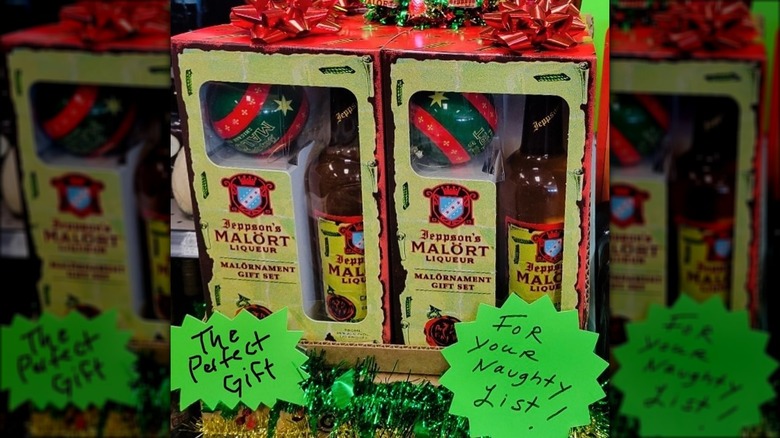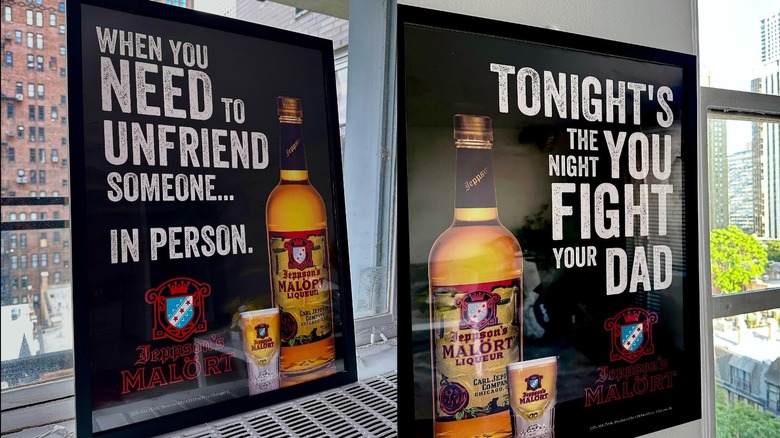Can The Chicagoan Liquor Jeppson's Malört Be Mixed Into Cocktails?
Jeppson's Malört is one of those rare products where the whole selling point is not how good it is, but rather, quite the opposite. It can often be found on, or even atop, lists of the world's worst-tasting alcoholic beverages (which is to say, worst-tasting beverages, period, since alcohol itself is a taste you have to work pretty hard to acquire). So what puts Malört in the company of such unusual booze as beer made with civet poop or whale testicles, whiskey distilled from urine, or gin infused with ants? More importantly, why are people still drinking the stuff? And is there anything you can do to make it taste slightly less, er, assertive?
To answer the first question, we don't know for sure, but for those of us in the U.S. it's probably quite a bit easier to come by than any of those other dubious booze brands. So more people have had a chance to try it and make the infamous "Malört face." As for the second, it seems to be a rite of passage or, for Chicagoans, a point of civic pride. As to whether there's anything you can do about the taste, well, unfortunately, a spoonful of sugar will not make the Malört go down in a most delightful way, but a well-chosen cocktail mixer might help to ease a little of the pain.
What is Jeppson's Malört?
Jeppson's Malört is a botanical liqueur made with wormwood, the same substance used in absinthe, Malört contains minimal thujone, though, so it's never spawned myths of inspiring visions, nor does it have a poetic nickname like green fairy. "Malört" simply means wormwood in Swedish, as the inventor was a Swedish immigrant named Carl Jeppson. (Interestingly enough, a variety of wormwood lent its name to a Ukrainian city where once that weed grew in abundance: Chernobyl, now better known as the site of the world's worst nuclear meltdown.) While Malört was once bottled with a stem of real wormwood, this is now no longer the case. At one point it was even made with wormwood extract, but is once again made with the real stuff.
Fun fact about Malört: It was birthed during Prohibition, and permitted because Jeppson marketed it as a cure for stomach parasites rather than a recreational beverage. He argued that the taste meant no one would voluntarily drink the stuff unless in dire need. He was probably right, too, although perhaps the Chicago authorities at the time may have been inclined to turn a blind eye to dire needs not of a strictly medicinal nature. Officially, however, the liqueur dates back to 1934 when it was first legally produced. It was originally sold as bäskbrännvin and then as Jeppson's Swedish Brännvin, but by the 1950s was marketed as Jeppson's Malört.
Malört was almost out of business by the early 00s
The long, strange history of Jeppson's Malört was almost at an end by the close of the 20th century, or so it seemed. Within a year or two of Amendment 21's making its manufacture legal, Carl Jeppson sold his bäskbrännvin recipe to a company called Bielzoff Products, but this company, in turn, was bought out and had its name changed to Red Horse Liquors in the 1940s. By 1953, Carl Jeppson Co. (a company named for, not owned by, the now-deceased Father of Malört) existed as a separate entity, but 33 years later the Chicago-based distillery that produced it went out of business. Malört was subsequently produced in Kentucky for a few years before finding a new home in Florida.
In the 2010s, a man named Sam Mechling became associated with the liqueur through his involvement in a bar-based comedy show that featured the product, social media posts he made, and even selling Malört merch. Owner Patricia Gabelick, who took over the reins in the late '90s, considered suing him but ultimately decided to partner with him instead. By 2019, Malört had even found its way back home to Chicago to be produced (and eventually purchased) by the city's CH Distillery.
How is Jeppson's Malört made?
According to legend (and, for all we know, fact), Malört was originally concocted in Carl Jeppson's kitchen, but today it's produced in a very industrial-looking distillery located in Chicago Pilsen neighborhood that's staffed by a crew of about 20 people. The first step in the Malört-making process involves fermenting rye and wheat to make grain alcohol which, in turn, is then distilled with wormwood to make a (more or less) drinkable product. This product is then decanted into clear glass bottles (the bottling machine produces 1,000 of these per hour) before being labeled, boxed up, and shipped out to bars and liquor stores nationwide.
From time to time, CH Distillery likes to mix things up a bit with its Malört making. During the pandemic, it was able to distill a very special batch of the product from beer sourced from closed-down bars, with Chicago's Revolution Brewing being the primary supplier. The following year, the distillery also released a limited batch of Malört that had been aged in oak barrels likely left over from its own bourbon-making operations. CH has plenty of these on hand as bäskbrännvin, even though not usually barrel-aged, isn't the only kind of booze it produces.
What does Jeppson's Malört taste like?
If you wanted to be flowery about it, you could describe Jeppson's Malört as having a symphony of flavors, but it would be a symphony in the key of yuck. Essentially, what it tastes like is wormwood, and wormwood tastes very bitter. While bitter flavors may have become trendy in recent years, it's possible that a certain part of this may be due to the fact that acquired tastes are seen by some as a sign of sophistication. That being said, Malört drinking tends to be more often presented as a challenge than an actual pleasure, and among the more colorful (yet still SFW) descriptions, via Reddit, include "hairspray and death," "grapefruit juice and gasoline [mixed] in a dirty bathtub," and "all of your hopes and dreams being snuffed out at once."
Less entertaining, but most likely more accurate, are accounts that characterize Malört as tasting similar to absinthe (since both are made with wormwood) or compare the bitterness to grapefruit rinds. Some feel it has a slight hint of bile, as well, but that does seem fairly plausible. (What, you didn't expect us to go out and try it now, did you? Sorry, we gave it up for Lent.) Barrel-aged Malört, which still appears to be available for purchase at the time of writing, is said to be a somewhat milder version of the original with sweeter, almost candy-like notes in addition to the bitterness of the wormwood.
How to use Jeppson's Malört in cocktails
The classic Malört mixed drink is a local spin on the boilermaker called a Chicago Handshake: a shot of Malört and a can of Old Style (a beer that's actually brewed in Wisconsin but has long been associated with the Windy City). While that drink leans into Malört's ick factor, some bartenders like to take on the challenge of using its bitterness as a balancing element in cocktails that include other flavors.
One such drink, a Malört spritz, masks its bitterness with grapefruit soda, which itself combines bitter with sweet, boosting the latter with hibiscus syrup and adding sour in the form of lime juice. Other cocktails go tiki style: The Chi Tai is a mai tai with a Malört float, while the Chicago Sling takes the Singapore one and adds cranberry gin and Malört. The Bitter Truth is a simpler drink that pairs Malört with gin, lemon, and simple syrup, while the Wormwood Sour tempers some of that bitter Malörtiness with whiskey, lemon, and egg white.
Malört even has a playful side, as witnessed in its inclusion in frozen drinks such as a grapefruit-mango lemonade-based Chicago Weather slushie served at Logan Square hipster bar The Native. Pepp's Pub, which is located some 900+ miles outside of Chicago in New Orleans, came up with a slushie of its own called Frolört, a margarita-ish concoction made with mezcal and Malört.
Where to buy Jeppson's Malört
Jeppson's Malört, while Chicago-born and bottled, may now be purchased at liquor stores and in bars and restaurants in 30 states. Even if you're in one of the 20 where it's not available, you may still be able to buy it online, depending on whether local laws permit the shipment of liquor. Malört's online shop currently sells it in standard 750-milliliter bottles along with half-sized 375-milliliter ones and there's even a 6-pack of 50-milliliter mini bottles perfect for stocking stuffers. While barrel-aged Malört is no longer available from the distiller, several online liquor stores (as previously mentioned) may still have it in stock, unless you're reading this piece years after publication, in which case all bets are off.
If you're located out of the U.S., however, your best bet for obtaining Jeppson's Malört may be to have a helpful friend (or random person recruited via social media) "gift" you a care package, although again this depends on shipping regulations as we're definitely not advocating that these be circumvented. If you're in Europe, though, there are other bäskbrännvin brands available, particularly if you're able to visit any of the Scandinavian countries. Among the ones recommended by one Redditor are Bäska Droppar, Kanal-Gräfvar-Sup, Piratens Besk, and Snälleröds Herr Berntsons Besk, although they did caution that these spirits may be stronger and even more bitter than Jeppson's Malört, so drinker beware.
Nutritional information about Jeppson's Malört
For all the mythology surrounding Jeppson's Malört (even the company's own advertising promotes it as being for times you need to "unfriend someone in person" and the kind of product that will make you "fight your dad"), you'd expect it to be some kind of anti-superfood with all sorts of toxic properties, but nope, nutrition-wise it's pretty much the same as any other hard liquor: 64 calories per ounce, with no fat, carbs, protein, vitamins, or minerals. It does come in at a slightly lower ABV than vodka, whiskey, or gin: 35% or 70 proof. This is still on the high side for the liqueur it claims to be, though, as liqueurs, as opposed to hard liquor, tend to top out around 30% (60 proof).
We did find one source claiming that Malört was the only kind of booze to get a nod of approval from the creators of the Whole30 diet. While the claims that the wormwood it contains may be beneficial to the digestive system may initially sound plausible, these are followed by a description of this "uniquely delicious" drink that's said to taste like "Sonic the Hedgehog's p*ss." These statements, allegedly attributed to an official Whole30 blog, caused us to take a closer look at the source. Yep, the Chicago Genius-Herald is, in fact, a satire publication and a pretty good one, at that. Sorry Whole30 adherents, but Malört's still not on the approved beverage list.
